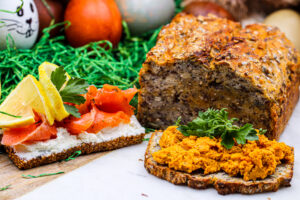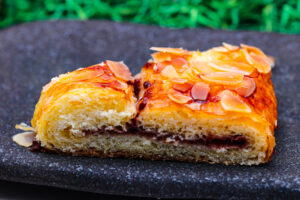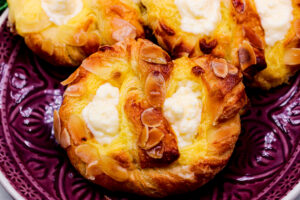Hanna&Mama
Cooking&Baking
04.2023
Easter Brunch
When the first warm rays of sunshine shine outside again and the first spring flowers bloom, then it is Easter again. Next to Christmas, Easter is the most important holiday in Germany. Like Christmas, about a month before the Easter holiday, it is the season for colorful Easter decorations throughout the house. The most important day of the Easter season is Easter Sunday. Traditionally, the whole family gathers to start the day with a grand Easter brunch. Afterwards, the children go out into the yard to look for chocolate Easter eggs and chocolate Easter bunnies. With this menu, I would like to show my students how to create a delicious Easter brunch buffet with wonderful Easter decorations.
The highlight of this menu is German folded pie dough, similar to French folded pie dough. I will show you step-by-step how easy it is to make this special pastry as well as popular savory and sweet recipes that use this dough.
Easter in Germany is also the season of cherry blossoms. And you and your friends will be delighted when you have a special hanami picnic with recipes from this menu.
Wishing all my students a joyful Easter time and a beautiful spring!
You WANT...
to know what you will get how to book a class how to download how to watch videos how to Zoom class schedule
to know about me about Konagami about Contact about Policies
recipes
This bread is very juicy, crunchy and fluffy. The apples and carrots make this bread very mild, and it goes well with sweet and salty toppings. Baked without sourdough, this bread has a soft dough that does not need to be kneaded or rested. All it takes is about 15 minutes to make all the dough, shape the loaf, and place it in the oven. The finished dough can be baked immediately.
Baking bread couldn’t be easier!

Since the symbol of Easter is the rabbit, I think a recipe with carrots would make a particularly good match. This is not a sweet spread, but a spicy one. Not only does it work very well with apple and carrot grain bread, but it is also a good contrast to the sweet cakes and chocolate eggs that are so common at Easter.
In addition, this spread is 100% vegan and the mix of ingredients makes it very nutritionally balanced and healthy.
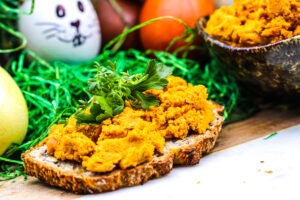
In Germany, smoked salmon and graved salmon are quite popular. Because it is somewhat rather expensive, it is not eaten every day, but is usually eaten at buffets or enjoyed on Sunday mornings at a leisurely breakfast.
Graved salmon (Swedish “gravad lax”, Danish “gravad laks”, etc.) literally means “dug-in salmon” or secondarily “marinated salmon” in current culinary terms. The method of preserving freshly caught salmon by lightly salting it and burying it in the ground for weeks or months to allow it to ferment was developed by the Scandinavians centuries ago, and the term gravlax can be traced back to 1348. In my home country of Northern Germany, gravlax has also been made for centuries.
Traditionally, the fish was gutted, rubbed with a pickling agent (a mixture of dry salt and sugar with dill and sometimes other spices and herbs), buried (Swedish “gravad”) on the beach or in the earth for at least three days and weighted down with stones. The physical pressure and osmotic pressure of the pickle draws the moisture out of the salmon meat. At the same time, the fish ferments somewhat in the process. The dryness and moderate fermentation make the environment less hospitable to other microorganisms that can cause spoilage, thus extending shelf life. In addition, in the past, the fish was left in the mine for many months to preserve it during the winter.
Today, of course, graved salmon is not marinated for weeks. Depending on the recipe, making the dish takes only a day or two.


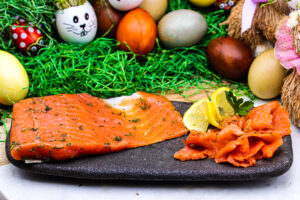
This cake is very popular in Germany. There is no cake more fitting for the Easter season. The dough contains a large amount of carrots, which makes the cake very moist. The carrots also keep the cake from drying out too quickly, so it is just as delicious and moist after three days as it was on the first day. The marzipan on the cake gives it a delicious sweetness and creaminess. You can also use marzipan to easily make cute Easter decorations.


This will be a little highlight at your breakfast table or picnic. A very chocolatey, juicy chocolate cake hidden in a real breakfast egg.

There are many egg-based decorations for Easter. Eggs stuffed with watercress are a special decoration idea that not only looks pretty, but also tastes very good and is healthy. These eggs are also very good to make with your children. This Easter decoration goes very well on a buffet as well as on an Easter breakfast table. Cress tastes great topped on bread with cream cheese, cheese, or ham, on natto with rice and raw eggs, or in salads.


The most important Easter decoration in Germany are colorfully painted Easter eggs. Colorfully painted empty eggs are hung in Easter bouquets throughout the house. However, boiled eggs are sometimes dyed and placed in small Easter nests to decorate the dining table or to prepare for Easter breakfast. Today, dyes for this purpose are sold in supermarkets, but many people in Germany still dye Easter eggs in the traditional way. Traditionally, natural ingredients usually found at home, such as vegetable peels, have been used as dyes. This recipe shows you how to dye beautiful Easter eggs easily for breakfast using a variety of ingredients.

Many people like French folded pastry dough and like to bake cakes with folded pastry dough, but most people buy folded pastry dough instead of making it themselves. Many people think that making folded pastry dough is difficult and very time-consuming. In this article, I would like to show you a quick and easy way to make your own German pastry pie crust, Plunder Pastry.
The name “Plunder” comes from “Pludern” or “Plustern”, meaning “to rise” or “to swell”. In English, plunder pastry or folded pastry dough is called “Danish” or “Danish pastry”, and in Nordic-speaking countries the term “Wienerbrot” is used.
Danish pastry is made in a similar way to French folded pastry. There are two major differences. First, Germany uses yeast to make the dough. Second, because the dough is already very fluffy thanks to the yeast, it has fewer layers than French folded pastry dough. Plunder pastry has 54 layers, while French folded pie dough usually has 128 layers.
German folded pastry dough can be used in the same way as French pie dough, such as for croissants or small apple pie pockets.
The following recipes show you how to make cakes and rolls of all sizes at the same time from just one dough.
“May wreath cake”, or “Maikringel” in German, is a classic cake made with folded pastry dough that is very popular in northern Germany. It is usually filled with prune jam or marzipan and topped with almonds and icing. May wreath cake makes a great picnic or family afternoon snack cake.



“Danish”, or “Kopenhagener” in German, is one of the most popular folded pastry dough recipes in Germany. Danish can be bought all year round in bakeries throughout Germany. They are crispy on the outside and creamy on the inside, filled with vanilla pudding and a variety of juicy fruits and berries. Danish is also very nice at buffets.



Pudding pretzels are especially popular with children. The fluffy, crunchy pretzel is filled with creamy sweet pudding and topped with roasted sliced almonds and lemon icing.
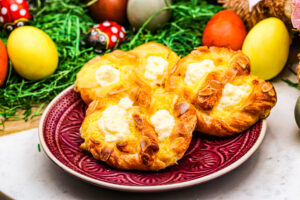
Pretzels are very popular. The reason for this is their special shape, dark brown color and salty taste. But pretzels are not the only things that can be cooked this way. Croissants, which are usually rather sweet, can also be baked as pretzel croissants using baking soda water. Pretzel croissants are very popular and can be found in many bakeries. With this recipe, you can bake special, unusual, and delicious croissants not only for yourself, but also for your family and friends.
You can easily bake pretzel triangles from folded pastry dough as well as pretzel croissants. Pretzel triangles are one of the easiest recipes to make from folded pastry dough. They are crispy on the outside and very fluffy and moist on the inside. Pretzel triangles can be eaten like a croissant or cut open like a bread roll and eaten with butter and, for example, cheese or ham. If you want to make the pretzel triangles even crispier, you can sprinkle them with seed mix or pizza cheese. When made into sandwiches, these pretzel triangles quickly become a special and delicious picnic, lunch or snack.



DATE
07 & 08 April 2023
In this time period you will have 2 days with Zoom Meetings for asking the teacher questions, meeting with other students and cook and bake LIVE together.
- Basic Croissant Pastry Dough
- Basic Croissant and Pretzel Croissant
- Pretzel Triangle
- Fruit Danish
- Danish Pudding Pretzel
TIME
3:00 PM – 6:00 PM
Tokio, Japan, local time
ZOOM MEETING TIME
- 3:00 – 6:00 PM: LIVE Class
Zoom Room OPEN
In the time period of the LIVE Class you can enter and connect to the teacher and other students; choose your day and time freely.
The Zoom classes will get recorded for those, who cannot participate or want to listen to the teacher`s advise again.
Short 5-10 minutes breaks will be held spontaniously during the LIVE class.
COST
6900 Yen
Recipe Download
You need your RECIPE DOWNLOAD PASSWORD for access!!
You can find it in your mail with the class details or on the "How to ...?" page of your recipe.
Click Here
Video Turorials
You need your VIDEO PAGE PASSWORD for access!!
You can find it in your mail with the class details or on the "How to ...?" page of your recipe.
Click Here

